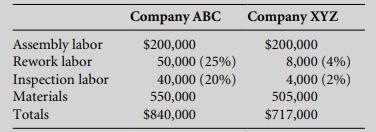The government invites two companies to bid for a contract to produce 100 flightline avionics maintenance systems.
Question:
The government invites two companies to bid for a contract to produce 100 flightline avionics maintenance systems. The design is owned by the air force, and the air force will provide all necessary documentation to the successful bidder. Both companies understand the requirements of the contract, and both are equipped and have the know-how to manufacture the devices.
Company ABC, with no SPC experience, develops a conservative proposal, accounting for 25% rework in its manufacturing labor costs, padding materials costs by 10% in anticipation of scrappage, and allowing for inspection sufficient to smoke out most of the defects—calculated at 20% of the basic manufacturing labor. Company XYZ, which uses SPC in all its manufacturing processes, bids rework and scrap at much lower rates and includes only enough inspection to audit processes and meet the customer’s own minimum inspection criteria.
The following chart compares the bids from the two companies:

With a difference of $123,000, there can be no doubt that Company XYZ will win the contract. Not only is Company ABC’s bid 17% higher, but also one would be safe in predicting that its higher-priced product would be inferior to XYZ’s product. SPC is the only difference here.
QUESTIONS
1. How would you rate the comparative competitiveness of the two companies?
2. If you work for a company that does not employ SPC, how could SPC help the firm?
Step by Step Answer:

Quality Management For Organizational Excellence Introduction To Total Quality
ISBN: 9780132558983
7th Edition
Authors: David L. Goetsch, Stanley B. Davis





